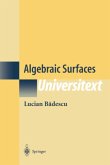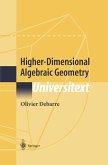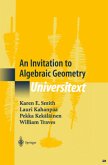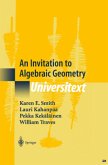The aim of this book is to present certain fundamental facts in the theory of algebraic surfaces, defined over an algebraically closed field lk of arbitrary characteristic. The book is based on a series of talks given by the author in the Algebraic Geometry seminar at the Faculty of Mathematics, University of Bucharest. The main goal is the classification of nonsingular projective surfaces (also called simply surfaces). In the context of complex algebraic varieties, the classification was obtained by Enriques and Castelnuovo. Around 1960, Kodaira [Kodl, Kod2] revived and simplified the classification of complex algebraic surfaces and extended it to the case of compact analytic surfaces. The problem of classifying surfaces in arbitrary characteristic remained open. The first step in this direction was the purely algebraic proof (valid in arbitrary characteristic), due to Zariski [Zarl, Zar2], of Castelnuovo's criterion of rationality. Then Mumford [Mum3, Mum4] introduced several new ideas, and the classification of surfaces in positive characteristic be came possible. Finally, Bombieri and Mumford [BMl, BM2] completed the classification of surfaces in arbitrary characteristic. Their result was the following: The same types of surfaces that exist in the case when lk is the complex field arise in the general case, if one sets aside certain pathologies that arise only in characteristic 2 or 3.
From the reviews:
"This is an excellent textbook, very good for a graduate course in algebraic geometry. ... The added exercises improve the quality of the book as a textbook. ... many new references are added to the ones in the original edition. ... I find very nice the last paragraph of every section, which contains bibliographic references; they reflect the author's point of view on the history of these mathematical discoveries and they give useful hints for further readings, both to students and to advanced researchers."
(Marco Andreatta, Mathematical Reviews, Issue 2001 k)
"The present book is a translation of an earlier Romanian text and one might ask: why publish it anew? ... first of all it is the only existing monograph treating classification of algebraic surfaces in all characteristics in a reasonably self-contained manner. Secondly, it is very carefully written and gives all the necessary references. ... My conclusion is that the monograph is a good introductory text for self-study or for a graduate course for anyone with the required background ... ."
(C. A. M. Peters, Nieuf Archief voor Wiskunde, Vol. 5/3 (4), 2002)
"The book under review is the translation into English of the Romanian original ... . As this excellent textbook on general algebraic surfaces has not suffered loss from its actuality ... it finally has conquered its deserved place within the international literature ... . The exposition is very clear, thorough, rigorous, elegant, and positively creative. This makes the book into a still very valuable source ... . Without any doubt, this is one of the very best books on algebraic surfaces, now as before."
(Werner Kleinert, Zentralblatt MATH, Vol. 965, 2001)
"The main aim of this book is to present a completely algebraic approach to the Enriques classification of smooth projective surfaces defined over an algebraically closed field of arbitrary characteristics. This algebraic approach is one of the novelties in comparison to existing textbooks on the subject."
(L'Enseignement Mathematique, Vol. 47 (1-2), 2001)
"This is an excellent textbook, very good for a graduate course in algebraic geometry. ... The added exercises improve the quality of the book as a textbook. ... many new references are added to the ones in the original edition. ... I find very nice the last paragraph of every section, which contains bibliographic references; they reflect the author's point of view on the history of these mathematical discoveries and they give useful hints for further readings, both to students and to advanced researchers."
(Marco Andreatta, Mathematical Reviews, Issue 2001 k)
"The present book is a translation of an earlier Romanian text and one might ask: why publish it anew? ... first of all it is the only existing monograph treating classification of algebraic surfaces in all characteristics in a reasonably self-contained manner. Secondly, it is very carefully written and gives all the necessary references. ... My conclusion is that the monograph is a good introductory text for self-study or for a graduate course for anyone with the required background ... ."
(C. A. M. Peters, Nieuf Archief voor Wiskunde, Vol. 5/3 (4), 2002)
"The book under review is the translation into English of the Romanian original ... . As this excellent textbook on general algebraic surfaces has not suffered loss from its actuality ... it finally has conquered its deserved place within the international literature ... . The exposition is very clear, thorough, rigorous, elegant, and positively creative. This makes the book into a still very valuable source ... . Without any doubt, this is one of the very best books on algebraic surfaces, now as before."
(Werner Kleinert, Zentralblatt MATH, Vol. 965, 2001)
"The main aim of this book is to present a completely algebraic approach to the Enriques classification of smooth projective surfaces defined over an algebraically closed field of arbitrary characteristics. This algebraic approach is one of the novelties in comparison to existing textbooks on the subject."
(L'Enseignement Mathematique, Vol. 47 (1-2), 2001)








